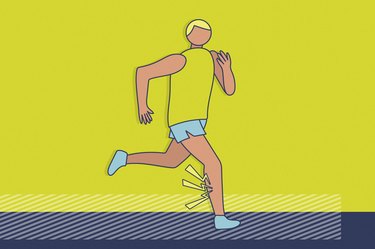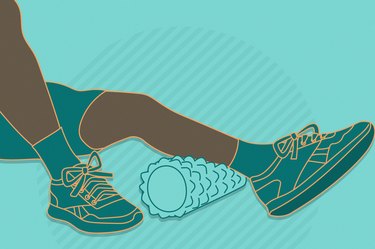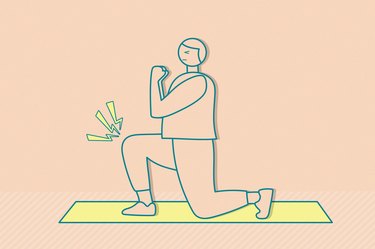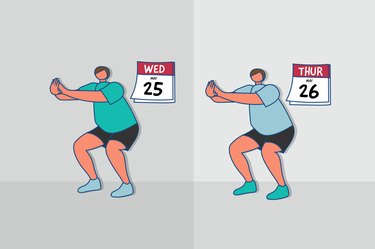
There's not much that can ruin a runner's high — except for that familiar (yet very much unwelcome) pain below your knee. Shin splints don't seem like such a cause for concern because they're so common, but can running with them actually cause lasting damage?
Before we dig into that answer, it's helpful to understand what shin splints are and why they happen. "Shin splints" is actually an umbrella term for different types of shin pain. The most common of which is in the lower leg bone, known as medial tibial stress syndrome (or MTSS). That's what most folks refer to when talking about shin splints, says Janet Hamilton, RCEP, CSCS, a registered clinical exercise physiologist and owner of Running Strong.
Video of the Day
Video of the Day
MTSS starts as an irritation of the connective tissue within your posterior tibialis, soleus or flexor digitorum muscles (all muscles around your foot and lower leg), according to Hamilton. "These muscles help to slow and control the motion known as pronation, when your foot strikes the ground," she tells LIVESTRONG.com.
Unfortunately, there are so many causes of shin splints, any runner is likely to experience it at one point or another. "Shin splints often coincide with a sudden increase in mileage, hills or speedwork," Hamilton says. And if you have weak hips, poor calf muscle flexibility or improper running sneakers, you're more likely to develop shin splints after a run, she says.
And here's the kicker: Continuing to run with shin splints can actually make things worse and can potentially lead to serious damage. Here's what you need to know about this overuse injury.
What Happens When You Run on Shin Splints
1. You May Get a Stress Fracture
Continuing to run with shin splints may wreak havoc on your bones. Initially, shin splints are just microtears in the connective tissue between your muscles and tendons or tendons and bones. But as you continue to run on damaged or weakened tissue, it can progress to a stress fracture (cracks in your bone), according to Hamilton.
Once you have a stress fracture, you're dealing with a much bigger issue. And the only way to heal a stress fracture is by using crutches or wearing a walking boot until the bones heal, which could take weeks to months, per the Cleveland Clinic.
2. You Can Get Other Injuries
To make up for the pain in your shins, you might overcompensate in other areas of your body, which can also lead to injury.
"If you're in pain when you run, there's a great likelihood that you'll make subtle changes to the way you run in an effort to alleviate the discomfort — and in doing so, you set the stage for your next running injury," Hamilton says.
Knee issues, hip issues, lower-back pain and plantar foot issues can all arise in response to running with shin splints, Hamilton says. These additional injuries can pop up in different areas based on your unique body structure, strength and flexibility.
"Your body is an intricate and well-connected biomechanical miracle, and if one area is not functioning well, other areas will experience increased stress or strain," Hamilton says. "You can turn a single injury — like medial tibial stress syndrome — into multiple injuries in multiple areas as these other tissues get beat up."
Warning
If your shin splints don't resolve after a few weeks of rest, it might be time to visit your doctor. Your doctor can test you for stress fractures or other conditions that could be causing the pain, per the Cleveland Clinic.
4 Ways to Prevent Shin Splints
The good news: There are ways to reduce your risk of getting shin splints in the first place. Follow Hamilton's tips below.
1. Run Smart
To steer clear of shin splints, build your fitness slowly, adding miles gradually. "Wait until you have a foundation of mileage before you venture into higher-intensity workouts like hills and speedwork," Hamilton says. "Run at paces that are appropriate for your current fitness level — most of the time, that means running at an easy, conversational pace."
2. Maintain Good Flexibility
All leg muscles are important for runners, but you'll want to pay particular attention to your calves, hamstrings, quads, inner thigh and glutes. Stretch your shins gently and stay consistent, Hamilton says. Try to stretch each day but especially during your cooldown routine.
3. Prioritize Hip Strength
"Pronation is controlled from above by a strong set of hips, and if [your hips] are weak, then the entire responsibility for controlling pronation falls on the relatively smaller lower leg muscles," Hamilton says. That added stress on your leg muscles can contribute to shin splints.
So, try to incorporate some hip-strengthening exercises into your workout routine, like lateral band walks and glute bridges.
4. Find Proper Running Shoes
Different runners have different feet and require different shoes. Translation: You need a pair of running shoes that works best for your body.
That's why Hamilton recommends buying running shoes based on what your foot needs rather than what's in style. Stop by a specialty running store to get properly fitted and track your shoe mileage, replacing your sneakers every 300 to 500 miles.
"Heavier runners or those whose feet pronate quite a bit may need to replace as frequently as every 300 miles," Hamilton says. "Lighter and more neutral athletes may be able to squeeze as much as 500 miles out of a pair of shoes."
4 Ways to Treat Shin Splints
When it comes to treating your shin splint pain, the best thing you can do is rest. You'll also want to avoid activities that directly stress the area, like prolonged standing, Hamilton says.
The following treatment methods can help alleviate shin splints, but, as mentioned above, it's best to talk to a medical professional if your pain doesn't resolve after a few weeks of rest.
1. Ice Regularly
Ice can help alleviate symptoms and may reduce inflammation, per the University of Chicago Medical Center. Try to ice regularly for 20 minutes at a time.
2. Use a Night Splint
Some people benefit from using resting night splints in addition to stretching their calves several times a day. "The night splint helps the foot to rest in a position of less downward pointing and thus keeps the calf muscle from being in a shortened position throughout the night," Hamilton says.
3. Enjoy Some Self-Massage
You can also try massaging the area a few times a day. "Massage can be helpful to address scar tissue and possibly stimulate circulation to the healing connective tissue," Hamilton says.
4. Consider Dry-Needling (With a Professional)
This treatment technique involves sticking a needle into a the affected area to help break up muscle tension and increase blood flow, according to the Mayo Clinic. Although this is a generally safe practice, it's something you want to do with a skilled physical therapist, Hamilton says.
Tip
Ultimately rest is the best shin splint treatment, but you'll need to address the underlying cause of your pain. "You can ice it and rub it till the cows come home but that won’t fix the problem," Hamilton says. "You have to deal with the root cause."
So, How Bad Is It Really to Keep Running With Shin Splints?
When it comes to running with shin splints, "just don't do it," Hamilton says.
Strapping on your sneakers and hitting the pavement with shin splints can lead to stress fractures and other serious injuries. And these outcomes can take way longer to heal than shin splints.
If you're experiencing shin pain, lay off the trail or treadmill, rest your legs and you'll be back to logging miles in no time.



